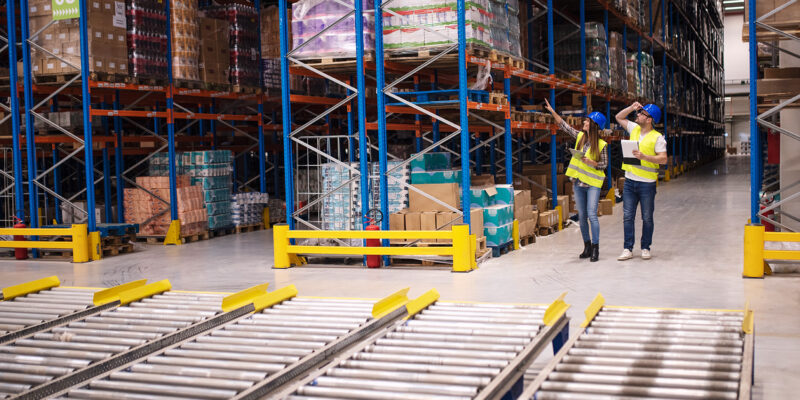
Climbing to New Heights: A Comprehensive Guide to Industrial Ladders
Ever had one of those heart-stopping moments when you’re perched precariously on a ladder, wondering if it’s sturdy enough to hold you? As someone who’s
Unlocking Efficiency: The Must-Have Material Handling Equipment for Optimal Operations
In today’s fast-paced business landscape, where efficiency is crucial for success, having the right material handling equipment can make a significant difference. Whether it’s a warehouse, manufacturing facility, or distribution center, efficient operations are essential to meet customer demands and maximize productivity. That’s where material handling equipment comes into play, enabling organizations to streamline processes, minimize errors, and reduce downtime. This article explores the importance of material handling equipment in unlocking efficiency, improving operations, and achieving optimal results. So, let’s dive into the world of material handling equipment and discover how it can revolutionize your business.

Revolutionize Your Operations: Unlock Efficiency with Cutting-Edge Material Handling Equipment
Efficient material handling equipment plays a vital role in enhancing operational efficiency across various industries. These tools and machinery help streamline processes, reducing human effort and errors while improving productivity. By eliminating manual tasks and automating repetitive operations, material handling equipment ensures optimal use of resources, time, and energy.
With the right equipment in place, businesses can benefit from increased efficiency in inventory management, order picking and processing, packaging, shipping, and more. By leveraging advanced technology and innovative features, material handling equipment optimizes workflows, enhances accuracy, and enables faster turnaround times. Thus, organizations can meet customer demands promptly and gain a competitive edge in the market.
Moreover, efficient material handling equipment ensures workplace safety by reducing the risk of injuries and accidents. From forklifts and pallet jacks to conveyor systems and automated guided vehicles, these tools come equipped with safety features and protocols, promoting a secure working environment for employees.
When investing in material handling equipment, several key features should be considered. Firstly, equipment ergonomics play a crucial role in improving operational efficiency. Ergonomically designed tools reduce physical strain on workers, maximizing their comfort and reducing the likelihood of injuries. Smooth manoeuvrability, adjustable heights, and user-friendly controls are crucial aspects to consider for ergonomic equipment.
Secondly, material handling equipment with advanced automation features can significantly enhance efficiency. Systems that integrate sensors, barcode scanners, and data tracking technologies streamline repetitive tasks, reduce errors, and enable real-time data analysis. Such automation not only ensures accuracy but also allows for intelligent decision-making and optimized resource allocation.
Lastly, durability is a key factor to ensure long-term efficiency. Investing in sturdy equipment built from high-quality materials helps minimize the need for frequent repairs or replacements. Robust machinery stands up to the rigors of daily operations and reduces downtime, allowing businesses to maintain consistent productivity levels.
Material handling equipment encompasses various types, each designed to accommodate specific operational needs. Forklifts, for instance, are widely used in warehouses and distribution centers to move heavy loads efficiently. They come in different sizes and capacities to cater to different warehouse layouts and load requirements.
Conveyor systems are another valuable category of material handling equipment. They can transport goods seamlessly within a facility, increasing efficiency by eliminating the need for manual lifting and carrying. Whether it’s a roller conveyor or a belt conveyor, these systems can significantly improve the speed and accuracy of material flow.
In addition, automated guided vehicles (AGVs) have gained popularity due to their ability to automate material transportation. AGVs can navigate through complex warehouse layouts using advanced navigation technologies, reducing labor costs and streamlining operations. These vehicles are especially useful in industries with high-volume material flow, such as e-commerce and manufacturing.
Implementing material handling equipment requires careful planning and execution to unlock maximum efficiency. The first step is to assess the operational needs and identify the specific challenges faced by the business. This analysis helps in selecting the right type of equipment that matches the workflow requirements and supports long-term goals.
Once the equipment is selected, thorough training of employees becomes essential. Adequate training ensures that workers can optimally utilize the machinery, follow safety protocols, and troubleshoot minor issues independently. Simultaneously, regular maintenance and inspections guarantee that the equipment remains in optimal working condition, minimizing downtime and maximizing efficiency.
Collaboration with expert material handling equipment providers can further streamline implementation. These providers offer professional guidance, helping businesses make informed decisions, tailor solutions to their specific needs, and stay updated with the latest industry advancements.
To sustain efficiency gains over the long term, regular maintenance and upgrades are vital for material handling equipment. Preventive maintenance schedules ensure that potential issues are identified and resolved proactively, reducing the risk of breakdowns and expensive repairs.
Upgrading equipment with the latest technology and enhancements can keep operations optimized as industries evolve. For example, integrating IoT (Internet of Things) capabilities into material handling equipment can enable real-time monitoring and data-driven insights for better decision-making.
By embracing a proactive approach to maintenance and upgrades, businesses can continue to unlock efficiency, adapt to changing demands, and maintain a competitive edge in their respective industries.
Material handling equipment plays a vital role in optimizing operations by streamlining workflows, enhancing productivity, and reducing operational costs. These equipment ensure smooth material flow, eliminating bottlenecks and minimizing downtime. By incorporating these tools, businesses can achieve faster order processing and improved customer satisfaction.
One of the primary benefits of material handling equipment is the ability to reduce manual labor. By automating tasks such as lifting, transporting, and sorting materials, businesses can reallocate human resources to value-added activities that require problem-solving and critical thinking. This not only increases productivity but also enhances employee morale and job satisfaction.
Moreover, material handling equipment helps balance workloads and optimally utilize resources. For example, automated storage and retrieval systems (AS/RS) efficiently manage inventory by automatically storing and retrieving items in designated areas. This reduces the need for additional storage space and improves inventory accuracy, resulting in cost savings and more efficient space utilization.
Several types of material handling equipment are known for their ability to enhance efficiency in operations. Conveyors, for instance, enable continuous material flow and significantly reduce the time required for manual transportation. They are especially effective in industries with high-volume production or distribution needs.
Pallet jacks are another widely used type of equipment for efficient material handling. These manual or electric-powered devices simplify the movement of heavy pallets within a facility, minimizing physical strain on workers and ensuring prompt deliveries of goods.
Another essential category of material handling equipment is cranes. Cranes can handle heavy loads, making them indispensable for construction sites, manufacturing plants, and shipping ports. With their ability to lift and move items with precision, cranes contribute to increased productivity and operational efficiency.
When choosing material handling equipment, several factors must be considered to ensure optimal operations. Firstly, it is essential to evaluate the specific needs of the business, such as the size and weight of materials being handled, the layout of the facility, and the required throughput.
Additionally, compatibility with existing infrastructure is crucial for seamless integration. Equipment should be selected based on its ability to fit into the current workflow and work well with other machinery.
The cost of acquisition and operational efficiency should also be evaluated. While investing in top-of-the-line equipment may lead to better performance, it is essential to strike a balance between cost and functionality to achieve optimal returns on investment.
Implementing material handling equipment requires careful planning and effective execution. One of the best practices is to involve cross-functional teams during the selection process – including individuals from operations, maintenance, and safety departments – to ensure that various perspectives are considered.
During the implementation phase, adequate training programs should be conducted to familiarize employees with using the equipment and following safety protocols. Clear communication channels should be established, allowing employees to provide feedback on any challenges or areas for improvement.
Regular inspections and maintenance checks should be performed to identify potential issues early on. Additionally, staying updated with industry advancements through collaboration with equipment suppliers helps businesses stay ahead of the curve and leverage new technologies for enhanced efficiency.
Maintenance and upgrades play a crucial role in maximizing efficiency in material handling operations. Regular inspections and preventive maintenance activities help identify and address equipment issues before they escalate, reducing downtime and preventing costly breakdowns.
Furthermore, upgrading material handling equipment with the latest technology can unlock additional efficiency gains. For example, implementing automated systems that utilize artificial intelligence (AI) and machine learning algorithms can optimize workflows
In today’s fast-paced business landscape unlocking efficiency in operations is crucial for sustainable success. Material handling equipment plays a vital role in optimizing operations and maximizing productivity. By investing in the right equipment businesses can streamline workflows reduce manual labor and ensure a smooth and efficient operation throughout the supply chain. Whether it’s using automated robots for inventory management or implementing state-of-the-art conveyor systems for seamless transportation incorporating the must-have material handling equipment can revolutionize the way businesses operate. Don’t miss an opportunity to unlock efficiency and stay ahead of the competition. Take action now and invest in the right material handling equipment to optimize your operations and unlock the full potential of your business.
When it comes to unlocking efficiency in operations having the right material handling equipment is crucial. There are several types of equipment that can help streamline processes and maximize productivity. Forklifts for instance are indispensable for lifting transporting and stacking heavy loads in warehouses or distribution centers. Conveyor systems are another must-have as they automate the movement of goods reducing manual labor and the risk of errors. Furthermore automated guided vehicles (AGVs) can optimize material flow by transporting items autonomously freeing up human resources for more complex tasks.
Investing in state-of-the-art material handling equipment has a profound impact on operational efficiency. These advanced technologies offer improved speed accuracy and reliability. For example automated picking systems can significantly reduce order processing times by using robotics and artificial intelligence to pick and sort items with precision. By integrating smart sensors and IoT connectivity managers gain real-time visibility into the supply chain enabling better decision-making and proactive maintenance. Ultimately embracing cutting-edge material handling equipment ensures optimal operations and a competitive edge in today’s fast-paced business landscape.
Absolutely! Implementing ergonomic material handling equipment not only priorities the wellbeing of employees but also enhances their productivity. Manual lifting and carrying heavy loads can lead to fatigue injuries and reduced morale. By providing workers with tools like lift-assist devices adjustable workstations and ergonomic pallet jacks companies can create a safer and more comfortable work environment. When employees are comfortable and supported their efficiency and morale soar. Investing in ergonomic equipment is an investment in both human capital and operational excellence.
The integration of material handling equipment with warehouse management systems (WMS) brings substantial benefits to operational efficiency. When WMS is seamlessly interconnected with equipment such as forklifts conveyors and automated storage and retrieval systems (AS/RS) it enables seamless data exchange and synchronized operations. This integration facilitates real-time inventory management accurate order tracking and efficient space utilization. For example an AS/RS can automatically replenish pick locations eliminating the need for manual intervention. By optimizing process flows and minimizing errors the integration between material handling equipment and WMS paves the way for optimal operations.
Absolutely! The constant advancement of technology brings forth exciting new possibilities for unlocking efficiency in operations. One emerging technology is the use of drones for material handling tasks in large warehouses or outdoor settings. Drones can quickly locate and transport items reducing human travel time and enhancing overall efficiency. Additionally the Internet of Things (IoT) integration allows for real-time tracking of assets predictive maintenance and improved decision-making. Moreover robotic process automation (RPA) is gaining traction enabling repetitive tasks to be automated further increasing productivity and precision. By staying abreast of these emerging technologies businesses can continue to optimize their operations and remain competitive.

Ever had one of those heart-stopping moments when you’re perched precariously on a ladder, wondering if it’s sturdy enough to hold you? As someone who’s

Have you ever battled a muddy mess of a driveway after a heavy rain? Or maybe your gravel path constantly seems to wash away. Traditional solutions like gravel or concrete can be expensive, time-consuming to install, and require frequent maintenance. But what if there was a better way?
Enter GeoCell, a revolutionary cellular confinement system that’s transforming the way we build strong, stable, and long-lasting driveways, paths, and even parking areas.

Spring brings fresh beginnings, warmer weather, and the perfect time for decluttering and dusting off neglected spaces. In the world of warehouse organization, implementing genius cleaning tricks can transform chaos into order. This article explores innovative spring cleaning hacks and decluttering tips tailored specifically for warehouses, shedding light on dust off techniques to optimize efficiency and productivity in your storage space.